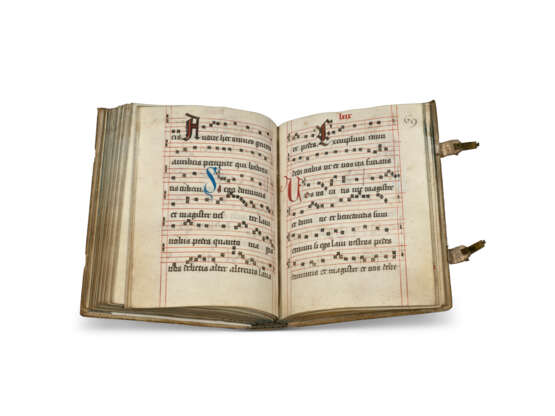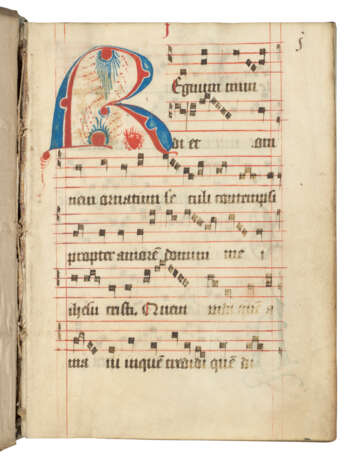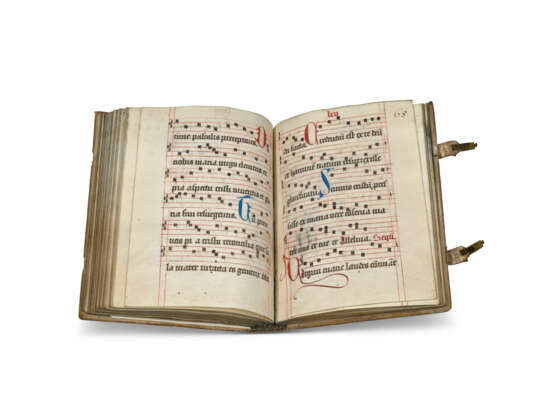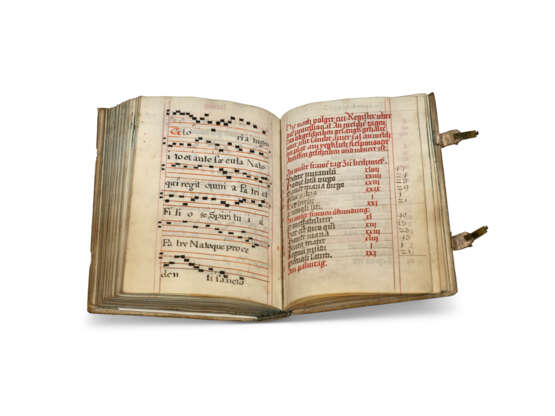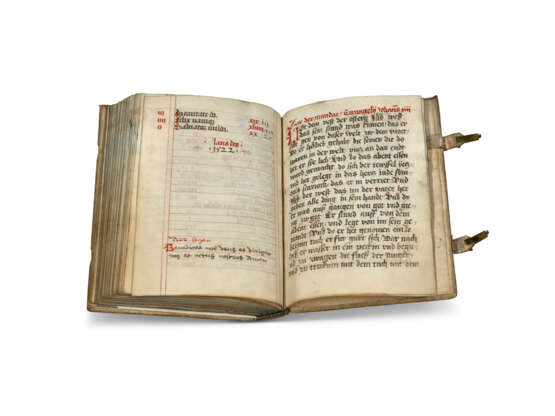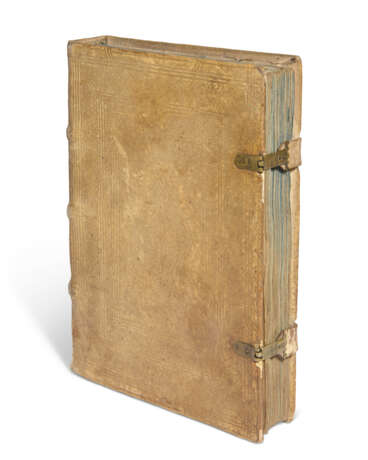ID 1349748
Lot 22 | A Birgittine Processional
Valeur estimée
£ 10 000 – 15 000
Birgittine Processional, for use at Maihingen, in German and Latin, decorated manuscript on vellum [Birgittine Abbey of Maihingen], 1522
A rare survival of Birgittine sung liturgy from the Bavarian Abbey of Maihingen.
200 x 150mm. 84 leaves, complete, collation: 1-108, 114, contemporary foliation in roman numerals in red and early foliation in Arabic numerals followed here, 6 lines of text and music on a four-line red stave, ruled space: 185 x 108mm, large painted initial on f.1, initials in red, blue or black-and-blue with occasional penwork flourishing, rubrics in red, early annotations in German (notation occasionally minimally faded, some light thumbing, overall in excellent condition). Bound in 16th-century blind-stamped pigskin over wooden boards, leather straps and brass clasps (lightly scuffed, darkened and rubbed). In a fitted red morocco box.
Provenance:
(1) The sequence of texts, the layout, and the index are identical to the Maihingen Processional now in the National Library of Sweden, A 92a, written by the same scribe throughout in 1499. Two other processionals for the use of Maihingen, also in large part identical to the manuscript in Stockholm, are in Germany: Munich, University Library MS 4° Cod. Ms 176 and Augsburg, University Library MS Cod. II I 4° 68. The present manuscript is closer to the manuscript in Stockholm than the Munich manuscript, which omits the ceremony for foot-washing (f.54 in the Stockholm manuscript and f.67v in the present manuscript) and a further short formula that belonged to the Feast of the Seven Maccabean Brothers. However, like the Munich and Augsburg manuscripts, the present manuscript is of a higher scribal quality, and, unlike the Stockholm manuscript, it contains rubrics in German that do not entirely related to the index at the end of the manuscript (on the manuscripts in Stockholm, Munich and Augsburg, and origins of and changes in the annual processional liturgy at Maihingen see V. Schier, ‘Writing and Rewriting Processions: The Reworking of the Procession Liturgy by the Birgittine Nuns of South Germany’, The Birgittine Experience, 2011, pp.268-284).
It seems likely that all four manuscripts were copied at or produced for the use of the Birgittine Abbey of Maria Mai in Maihingen, in Bavaria, in the diocese of Augsburg. The Stockholm and Augsburg manuscripts must have remained in the possession of the monastery until its dissolution at the end of the 16th century: the preponderance of later annotations in German in the present manuscript also indicates its continued use in a monastic setting until at least the end of the century. The Stockholm and Augsburg manuscripts were then integrated into the collections of the new Franciscan monastery at Maihingen and subsequently became part of the library of the princes of Oettingen-Wallerstein.
(2) William Ewart Gladstone, Prime Minister (1809-1898): Hawarden Castle library label, KK I 4.
Content: Processional, for the use of the Birgittine nuns at Maihingen, ff.1-78; Index ff.79-82v; excerpt from the Gospel of John 13, on Easter, in German, ff.83-84.
St Birgitta envisaged each Abbey as having a preponderance of nuns, up to sixty, and far fewer monks, twenty-five, to be the essential priests and deacons and lay brothers for manual labour. Their role was, in a sense, to support the nuns, to teach them Latin so that they could understand the liturgy which filled their lives. Central to Birgitta’s vision was the celebration of the Virgin by women throughout each day. ‘A tightly knit system of rituals not only governed and controlled the daily routine of every Birgittine nun, it indeed determined most elements of her self-understanding for the rest of her life, once she entered the monastery on the day of her profession’ (V. Schier, 2011, p.268). The monks followed the full breviary offices of the region of each abbey, but sisters would sing their own daily prayers in honour of the Virgin Mary, a Cantus sororum, which is the only medieval liturgy specifically compiled for a female order. The lessons were said to have been dictated to the saint by an angel and then translated into Latin from Birgitta’s Swedish by Master Peter Olafsson of Skänninge (1298-1378), who was responsible for shaping the office and writing the hymns.
The Rule of St Birgitta connects the nun’s cloister to an important event in the weekly liturgy: the Friday procession. In addition, processions through the cloister accompanied by chants were mandated on high feast days (Palm Sunday, Easter, Ascension, Pentecost, etc.). ‘With the exception of the prescriptions for the Friday procession, the Rule and its commentaries remain silent about the specifics of the rituals employed. The only other sources that we can consult in order to gain insights into the processional liturgy of the Birgittine nuns are processionals, manuscripts that contain the necessary chants in a portable format’ (V. Schier, 2011, p.269).
Following the Reformation, the monasteries in the Nordic and Baltic countries were abolished and large swathes of their once-famous libraries were lost. Others, such as Mahingen, were plundered during the Revolution of 1525 and never recovered their former glory. Consequently, early sources such as the present manuscript for the Birgittine liturgy are extremely rare.
| Lieu d'origine: | Europe de l'Ouest, Allemagne, Europe |
|---|---|
| Catégorie maison de vente aux enchères: | Manuscrits médiévaux et de la Renaissance, Livres et manuscrits |
| Lieu d'origine: | Europe de l'Ouest, Allemagne, Europe |
|---|---|
| Catégorie maison de vente aux enchères: | Manuscrits médiévaux et de la Renaissance, Livres et manuscrits |
| Adresse de l'enchère |
CHRISTIE'S 8 King Street, St. James's SW1Y 6QT London Royaume-Uni | |
|---|---|---|
| Aperçu |
| |
| Téléphone | +44 (0)20 7839 9060 | |
| Commission | see on Website | |
| Conditions d'utilisation | Conditions d'utilisation |
